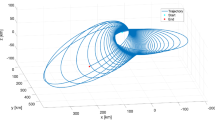Abstract
When the navigation satellite GEO performs a station keeping, high-precision orbit elements are required. The analytical solution can hardly meet the high-precision requirement while the spectrum analysis method based on Fourier analysis theory has limitations. The Hilbert-Huang transform theory decomposes the signal adaptively into a finite number of intrinsic modes and residual signals that characterize the trend of the signal through empirical mode decomposition. It is strong adaptable and frequency sensitive, so that it can give spectral analysis to the oscular orbit ephemeris sequence effectively. By analyzing the data of Beidou 3G01 satellite positioned on November 9th, 2018, a clear time-varying frequency and a set of mean orbit elements that characterize the mean motion are obtained.
Access this chapter
Tax calculation will be finalised at checkout
Purchases are for personal use only
Similar content being viewed by others
References
Li H, Gao Y, Yu P et al (2009) Research on co-location control strategy of geostationary orbit. J Astronaut 30(3):967–973
Kozai Y (1959) The motion of a close earth satellite. Astron J 64:367
Brouwer D (1959) Solution of the problem of artificial satellite theory without drag. Astron J 64:378
Liu C, Li F (2018) Perturbation analysis method for Influence of satellite orbit error on positioning accuracy. Astron Res Technol 15(1):40–45
Liu L (1975) An artificial earth satellite perturbation calculation method. Astron J 16(1):5–80
Huang NE, Shen Z, Long SR et al (1971) The empirical mode decomposition and the Hilbert spectrum for nonlinear and non-stationary time series analysis. Proc Roy Soc Lond A: Math Phys Eng Sci 1998(454):903–995
Huang NE, Wu MLC, Long SR et al (2003) A confidence limit for the empirical mode decomposition and Hilbert spectral analysis. Proc Roy Soc Lond A: Math Phys Eng Sci 459(2037):2317–2345
Rilling G, Flandrin P, Goncalves P (2003) On empirical mode decomposition and its algorithms. In: IEEE-EURASIP workshop on nonlinear signal and image processing. NSIP 2003, Grado (I), vol 3, pp 8–11
Huang NE (2000) New method for nonlinear and nonstationary time series analysis: empirical mode decomposition and Hilbert spectral analysis. In: Wavelet applications VII, vol 4056. International Society for Optics and Photonics, pp 197–210
Feldman M, Seibold S (1999) Damage diagnosis of rotors: application of Hilbert transform and multihypothesis testing. J Vib Control 5(3):421–442
Feldman M (1997) Non-linear free vibration identification via the Hilbert transform. J Sound Vib 208(3):475–489
Chen Z, Zheng S (2003) Analysis of edge effect of EMD signal analysis method. Data Acquis Process 18(1):114–118
Author information
Authors and Affiliations
Corresponding author
Editor information
Editors and Affiliations
Rights and permissions
Copyright information
© 2019 Springer Nature Singapore Pte Ltd.
About this paper
Cite this paper
Ye, N., Li, H., Zhong, W., He, Y., Ren, Y. (2019). Calculating the Mean Orbit Elements of Navigation Satellites Using Hilbert-Huang Transformation. In: Sun, J., Yang, C., Yang, Y. (eds) China Satellite Navigation Conference (CSNC) 2019 Proceedings. CSNC 2019. Lecture Notes in Electrical Engineering, vol 563. Springer, Singapore. https://doi.org/10.1007/978-981-13-7759-4_1
Download citation
DOI: https://doi.org/10.1007/978-981-13-7759-4_1
Published:
Publisher Name: Springer, Singapore
Print ISBN: 978-981-13-7758-7
Online ISBN: 978-981-13-7759-4
eBook Packages: EngineeringEngineering (R0)




